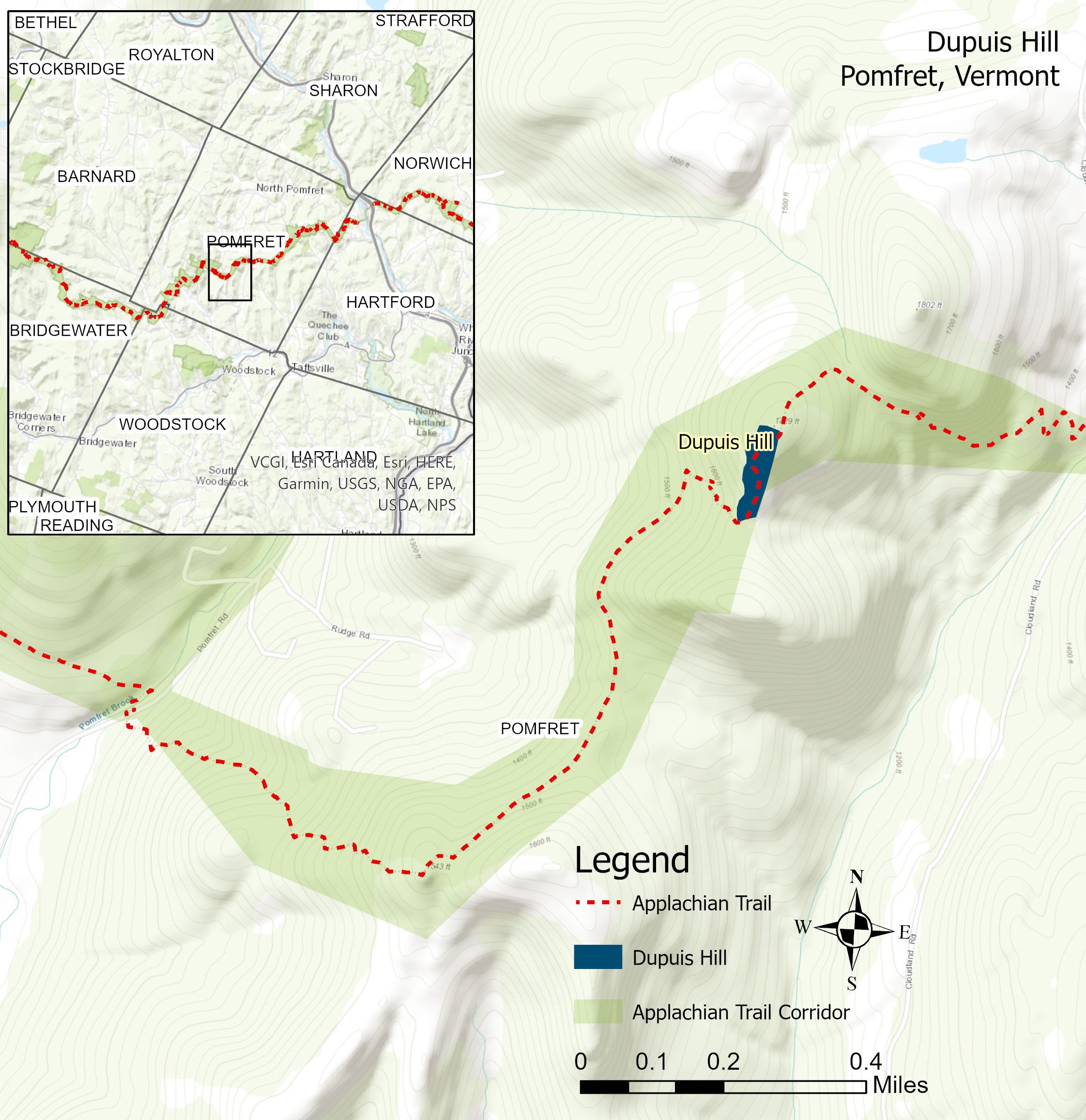
What makes a National Scenic Trail scenic? What is the significance of one scenic vista? How much time and money should be put into maintaining one view?
These were some of the questions debated by US Forest Service (USFS), Appalachian Trail Conservancy (ATC) and Green Mountain Club (GMC) staff as we stood on the Appalachian Trail, atop Dupuis Hill in Pomfret in June 2021.
Dupuis Hill is one of two dozen “open areas” along the Appalachian Trail (AT) in Vermont that are remnants of the rich agricultural history of the region. When the AT was first routed through the Upper Valley, the trail threaded through stretches of active agricultural fields, affording hikers sweeping views and a connection with the local community. As land use patterns changed in the 20th century, many hill top agricultural fields were abandoned and the ever-eager northern hardwood forests began to retake the hilltops. As a result, the character of the trail, especially between Killington and Norwich, changed. The hiking community realized what was being lost, and land managers at GMC, ATC, USFS and stalwart volunteers worked off and on to keep a handful of fields open.
Today, these land managers work together to keep 19 fields open with the goals of providing views for hikers, maintaining the agricultural character of the region, suppressing invasive species, and providing meadow environments for wildlife. Some fields are still hayed by local farmers who have Special Use Permits with the National Park Service, while others are mowed by GMC and USFS.
Dupuis Hill was used for sheep and cattle grazing into the mid-1900s. By 1980 the pasture had been abandoned but a 360-degree view was still visible from its summit. In the subsequent decades, however, trees began overtaking the area and obstructing the views. Today only a view to the southwest remains.
Reclaiming the Open View
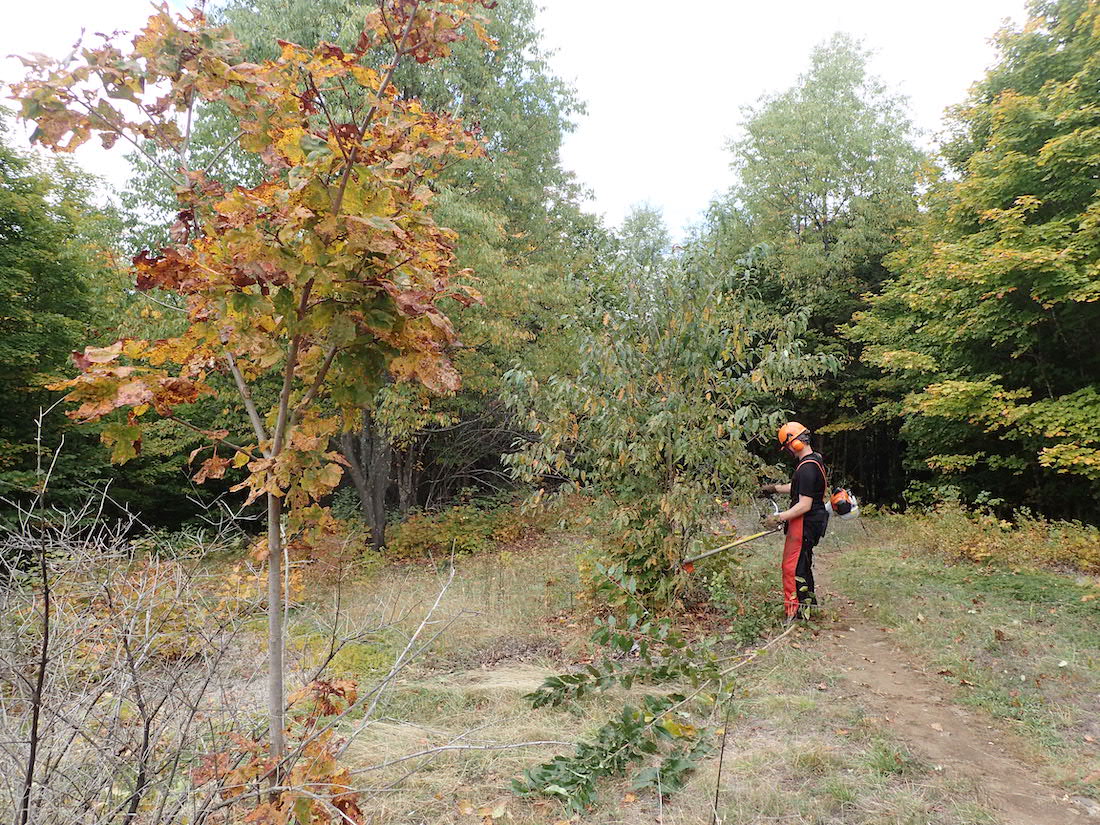
In 2016, GMC’s five-person Long Trail Patrol worked for five days with brush cutters and brush hog mower to ‘reclaim’ a 3 acre area at the top of Dupuis Hill. Only after clearing did we determine the full range of challenges to manage the site. Those challenges include:
- Its remote location, ¾ of a mile from the nearest road access.
- Its ledgy terrain, with numerous boulders and rocks poking above the ground that create hazards for mowers.
- Its vigorous vegetation cover, especially a dense stand of cherry saplings that grow 3-4 feet a year and quickly obscure the main view to the southwest from the top of the hill.
- Its significant invasive plant populations, mainly honeysuckle, that threaten to degrade wildlife habitat in the field.
GMC and the Forest Service tried doing follow up mowings of the field in 2018 and 2019 respectively, but both determined that the site was too challenging for this time-consuming model of maintenance.
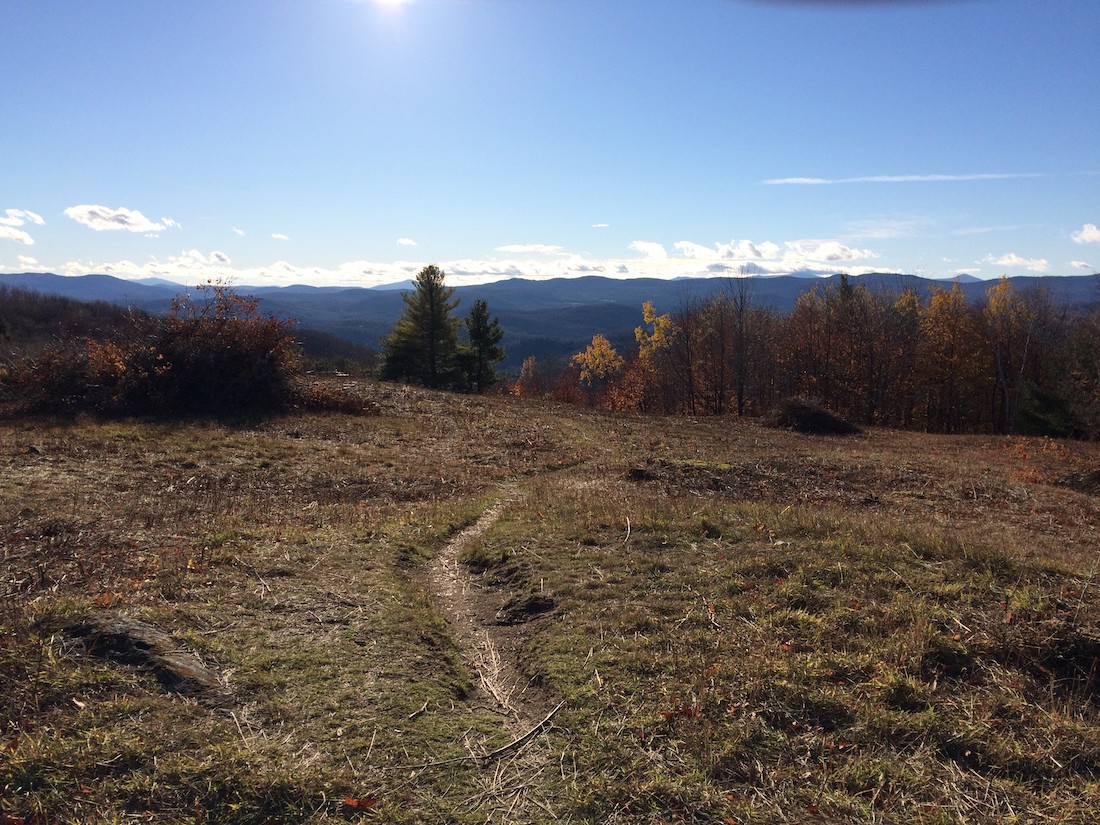
With that management history, we stood on the hill in June, considering a new approach to managing the field. Challenges aside, no one was prepared to give up on the site. It provides a unique view of Killington Peak and the Green Mountains, the last view of the range for northbound AT hikers in Vermont. It is also a popular day hike destination.
All Hands on Deck to Address Open Areas Management Challenge
We ended up landing on an all-hands-on-deck approach. One massive workday where each organization would bring their resources together to tackle the task. Together we would have the range of tools, know-how, and person-power to get the job done, which none of us could muster on our own. Our goal was to get 10-15 people together to knock out the task in one day with brush cutters, chainsaws, and walk-behind mowers. To prep for that day, we would also do a summer herbicide treatment of the invasive plants which would suppress their population and prep the site for mowing in the fall.
We didn’t know if it would be successful, but thought it was worth a try.
On August 25th two staff members from ATC and two from GMC hauled twelve gallons of herbicide the ¾ of a mile up to the field and treated all the invasive plants that could be found within the main portion of the open area.
On October 13th two GMC staff members, three ATC staffers, and six USFS staff members tackled Dupuis Hill for one massive workday. With five brush cutters, three chainsaws, two walk behind mowers and an ATV, there were more pieces of power equipment than people. A constant mechanical drone echoed off the hill all day, but by 3 p.m., we had cleared the open area of all woody growth, mowed the main field, and girdled the white pine trees that had been growing up into the view.
88 person hours, approximately 10 gallons of gas (not including transportation to the site) and the job was done — at least for the next couple of years.
Was this new approach a success? Should we do it all over again in two years as our management approach for Dupuis Hill going forward? How much time and money should be put into maintaining one view?
GMC, ATC, and the Forest Service will keep considering these questions as we constantly reevaluate Dupuis Hill and the other fields in our Open Areas Initiative.
In the meantime, please hike up Dupuis Hill to enjoy the view and consider these questions for yourself!
Before
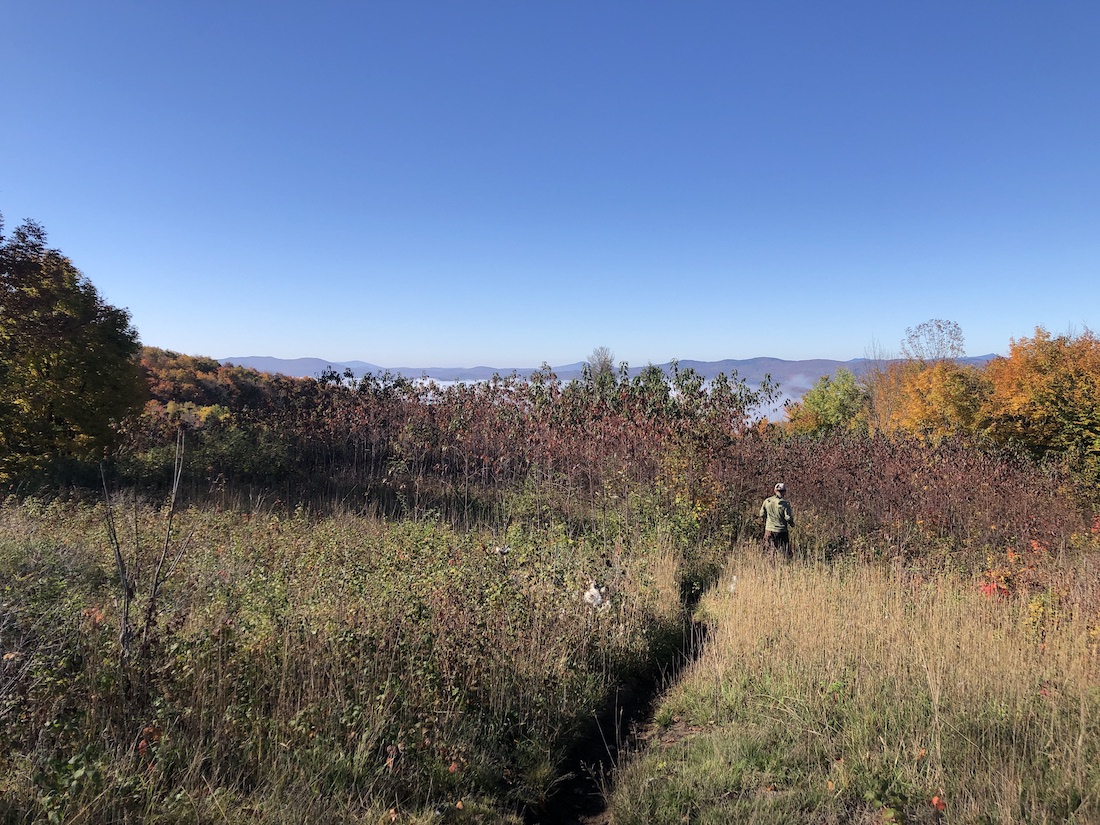
After
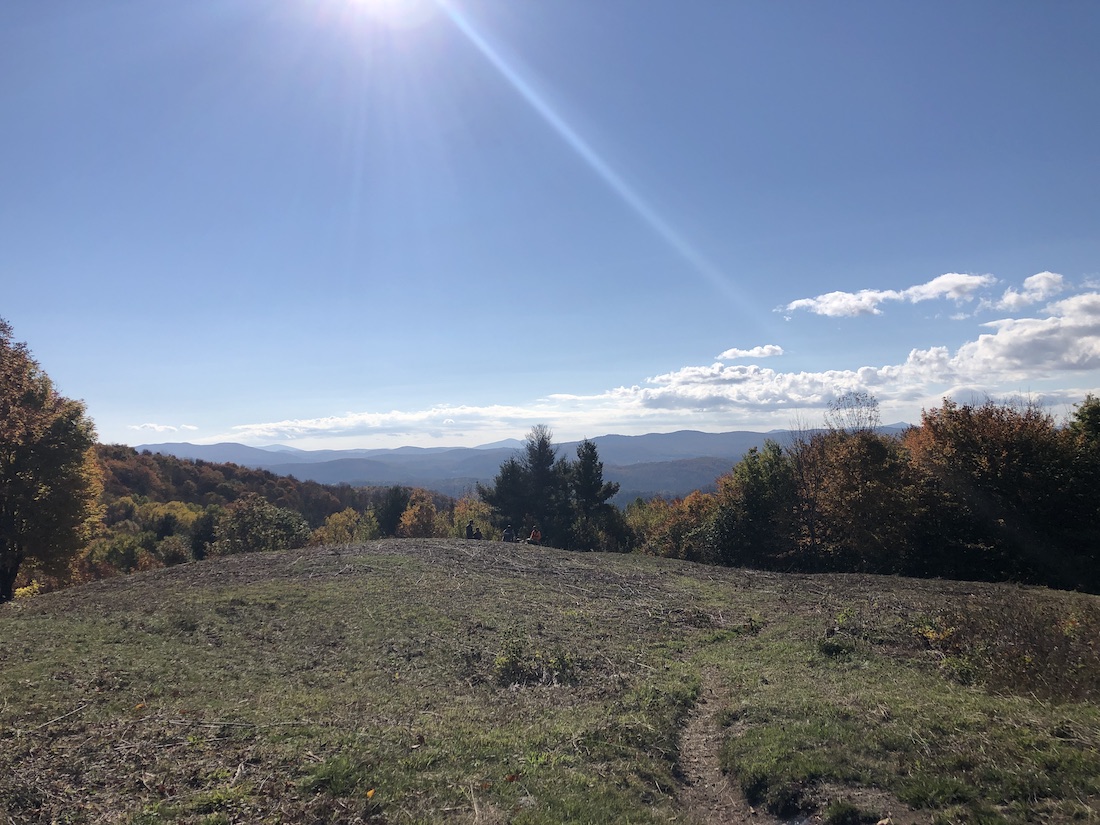
This post was written by Mollie Klepack Flanigan, GMC Conservation Manager. For more information on the AT Open Areas initiative, contact Mollie at [email protected]





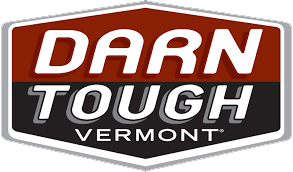













Perhaps having a herd of goats on the area once a year would keep the area open. Just a thought.
Requires fencing!? Preditor protection, human supervision!?
I agree. In the southern AT regions I have witnessed goats, ponies, and even long horned cattle. The livestock was semi wild and used to help maintain the balds. Seeing these animals didn’t distract but rather enhance my hiking experience.
If you treat it like a utilities maintenance program and develop it into a four year cycle doing 25% of the project’s annually. You would have to cut, trim and spray down to an acceptable level that would last 4 years.
I would love to hike the trail one day but I don’t think my life has it in my cards but WOW what am amazing difference that made. I understand that it was a LOT of work but it made a huge difference!
Why is it man thinks it better able to address a “view” than nature? After all, was it not manufactured originally? This is vanity at best…self serving in totality.
Wonder what they used for Herbacide? Wonder how many non invasive species it killed as well?
Most things on this planet can be improved.
Even some of the views.
I live in Alabama. I have lots of equipment for that same purpose. I would consider a work vacation, to pitch in. That sort of work is best done with all hands on deck. No fun to be the only one with the gear.